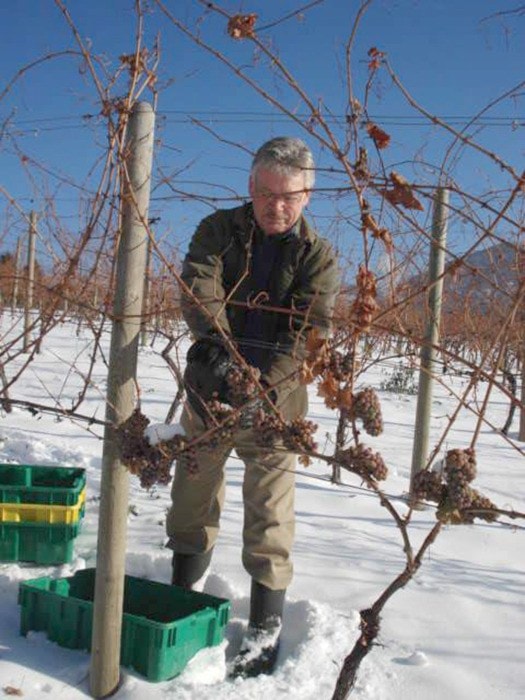When Al and Marleen Hoag went looking for a winemaker for their planned winery, they travelled to New Zealand. Someone with cool climate winemaking experience would fit the bill, and they headed south, custom brochures in hand.
They visited winemakers, made some contacts and, on the last day of their trip, they stopped in at Floating Mountain Winery in the Waipara Valley. No one was around, so they left a brochure — it described the Creston Valley and the vineyard, with its various plantings, and the Hoags’ need for a winemaker — on the winery door.
“We were away that weekend and came home,” Mark Rattray recalls. “I went out to the winery and there was a brochure stuck in the door. Al and Marleen had put together this little brochure talking about a job opportunity in Canada.
“They were on their way back to Canada, sort of slightly disappointed that they hadn’t really succeeded. But they got home to find an email from me.”
Now, with seven Creston Valley vintages behind him (he stayed in New Zealand in 2012 and consulted by Skype and email — his new wife, Christine, didn’t want him to leave home so early in their marriage), Rattray has a good grasp of the potential for the wine industry in the Kootenays. He also notes some vast differences in the marketplace.
In the Creston area, he says, future vineyards will have to have to be site-specific.
“I think there are probably other spots that might do okay, but Al might just have selected the best site in the entire valley,” he said.
To date, the Creston Valley’s small wine industry is clustered primarily around Skimmerhorn. Baillie-Grohman Estate Winery and its vineyard is next store, while John and Sandy Haley grow several acres of grapes just across the road. Most of their production is sold by contract. Wynnwood Cellars is located in Wynndel, about 15 minutes to the north and its primary vineyard is a few kilometers further north, on a hillside that slopes down to the shores of Duck Lake.
The Skimmerhorn vineyard is planted to cool climate varieties — Gewurztraminer, Ortega, Pinot Gris, Pinot Noir and Marechal Foch. It also includes some test plantings, including a row of Riesling.
“I’d like to try doing a botrytis-affected late harvest wine,” Rattray says. But Creston Valley doesn’t have the moist air that promotes the fungus’s growth. The desired botrytis for winemakers is referred to as noble rot. It settles on the fruits’ skin and promotes desiccation, leading to highly concentrated flavours. Botrytis can occur naturally, but it can also be introduced to a vineyard with sprays.
Rattray says part of his enjoyment in working at Skimmerhorn has come as a result of Al Hoag’s willingness to experiment. Earlier this year, Hoag bought a still to produce alcohol, which he used to make a fortified port-style wine by blending Marechal Foch and cherry wine. Now on the market, it’s called, cleverly, Old Koot.
“Al has a good knack for marketing and he knows what his customers like,” he says.
The New Zealand wine industry blossomed in the early 1980s, several years before B.C.’s renaissance began.
“The N.Z. business is basically export because there’ no population. With four million people you’re not going to get very far. It’s difficult to start up a winery thinking you’re only going to sell in New Zealand. The first thing you notice when you get to the U.S. or Canada is that you’ve got a population and that makes it a lot easier. The first time I got to the states, I was gob-smacked — I could see these guys have got it made. Lots of people with so much money.”
“Sauvignon Blanc still accounts for over 80 per cent of our exports,” he says. Pinot Noir has grown in popularity, and quality, but neither is what emerging markets like China are looking for.
“They like big red wines, like Merlot,” Rattray says.
By contrast, the vast majority of wine produce in B.C. is sold and consumed right here in the province.
When we spoke about the debate about whether B.C. should continue with producing whatever varietals grow best in a given vineyard or to focus one or two varieties, Rattray leans toward the latter.
“For a long time in New Zealand you’d have a vineyard and you’d grow every grape variety — you’d have 10 different varieties growing in exactly the same climate and exactly the same soil,” he laughs, shaking his head. “And it probably doesn’t work that well in the end, so you really probably ought to identify some grapes and push it.”
Pinot Gris and Pinot Noir come immediately to mind, he says.
With more than 40 years of winemaking experience it is clear that Rattray has enjoyed this latest phase of his career. Back home, he and a partner run a winery supply business and he produces about 500 cases of wine under his own name, using grapes he purchases.
And he hopes to continue in his role with Skimmerhorn.
“Oh yeah,” he smiles, “I’d like to keep coming back as long as they’ll have me.”
Lorne Eckersley is the publisher of the Creston Valley Advance. His website, www.lorneeckersley.com, features a collection of columns, stories and photographs about wine, beer and spirits, food, travel and arts.
